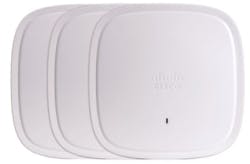Earlier this year, the IEEE released its 802.11ax Enhancements for High Efficiency Wireless (HEW) LAN standard, known commonly as Wi-Fi 6. This new advanced Wi-Fi application is positioned to theoretically deliver close to 10 Gig transmission through the use of eight spacial streams that each transmit at 1.2 Gb/s compared to Wi-Fi 5 (802.11ac) at just 866 Mb/s per special stream. It also has the ability to operate in both the 2.4 GHz and 5 GHz bands.
When introduction of Wi-Fi 5 finally gave us wireless speeds beyond 1 Gb/s, 2.5GBASE-T and 5GBASE-T were introduced by the IEEE to allow the installed base of Category 5e and Category 6 to potentially provide support. However, not all existing Cat 5e and 6 cable plants are guaranteed to support 2.5/5GBASE-T to 100 meters, and they must be tested to ensure compliance. With Wi-Fi 6 devices hitting the market, now what will you need to test to? Let’s take a look.It Takes TwoWhile the first wave of Wi-Fi 6 products may be supported by 2.5GBASE-T or 5GBASE-T, as the second and third wave of products hit the market and push speeds beyond 5 Gb/s, two 5GBASE-T connections may be required to each wireless access point to support link aggregation. And as the technology continues to advance and eventually deliver its maximum theoretical throughput, each Wi-Fi access point may ultimately require two 10GBASE-T connections, which requires a minimum of Cat 6A.
While you might start out testing for 2.5 or 5GBASE-T over Cat 5e or 6 for those customers who have not yet upgraded their cabling plant, most enterprise businesses deploying new cable plants are choosing to go with Cat 6A for Wi-Fi – even if they’re only using Cat 5e or 6 for the rest of the horizontal LAN. For those customers, it makes sense to test to 10GBASE-T today even if they’re not going to use it right away – and that requires alien crosstalk testing.
Just to refresh, alien crosstalk testing involves testing a sampling of short, medium and long disturbed links for power sum alien near-end crosstalk (PS ANEXT) and power sum attenuation to alien crosstalk ratio far-end (PSASCRF). When sample testing disturbed links for alien crosstalk, remember to choose links within the same bundle and those surrounded above and below by connectors rather that links that terminate at the end of a row of connectors. This will help ensure you’re testing worst-case scenario links, and if they all exceeds 5 dB in margin, you’re in good shape. To learn more about Alien Crosstalk testing, read this post: https://www.flukenetworks.com/blog/cabling-chronicles/field-testing-misconceptions-alien-crosstalk-do-we-test-or-not-if-so-how
If you (or your customer) are not up for the additional time required for alien crosstalk testing (and if you don’t need to do it for warranty purposes per the cabling vendor), you can take a look at TCL and ELTCTL test results by choosing (+ALL) limits on the DSX CableAnalyzer Series tester. These parameters only add about 6 seconds to your test times, and they are excellent indicators of whether a cable link will provide adequate alien crosstalk performance. And if the cabling is shielded, you likely won’t need to worry noise from neighboring cables at all.
More Power to Consider
Another key aspect of Wi-Fi 6 access points is that their more complex processing will require higher levels of PoE than we’ve seen for previous generations of Wi-Fi that have primarily operated within the 13 W of Type 1 PoE. That means 30 W Type 2 PoE at a minimum, and in some higher-end access points you may be looking at 60 W Type 3 PoE.
If you know the link will be delivering power to a Wi-Fi 6 access point, it would be wise to test for DC resistance unbalance to ensure that when DC power is transmitted via common-mode voltage, it is split evenly between each conductor of the pair and between multiple pairs for four-pair PoE applications. Because if it’s not, Ethernet signals can become distorted, causing bit errors, retransmits and even nonfunctioning data links. The combination of high-speed 10GBASE-T, higher power PoE and the fact that more of us every day are connecting wirelessly is what makes Wi-Fi 6 the most significant modern technology substantiating the need for this DC resistance testing – which is thankfully available on the DSX CableAnalyzer Series tester by selecting (+All) or (+PoE) limits.
If the cabling plant has already been installed and activated, you can check how much power is available on the link using Fluke Networks’ MicroScanner PoE. Simply plug it into the end connection, and if the cable is connected to a PoE switch or other Power Sourcing Equipment (PSE), it will display the class (0-8) of power available on the link. You can then compare that to the requirements of the wireless access point to know if enough power will be available. Click HERE to learn more about PoE classes, types and standards.
Shielded for Protection
Because Wi-Fi 6 deployments are susceptible to both alien crosstalk and heat rise caused by delivery of PoE in cable bundles, don’t be surprised if some of your customers are using Cat 6A shielded cabling for their access point connections. But don’t forget that if it’s not installed correctly, even shielded cabling can fail. In the telecom room, a shielded cabling run from one patch panel to another that has an open shield can actually fail alien crosstalk testing.
Simply testing for DC continuity may not be enough. The DC electrical signal will look for any path it can to get to the other end, including through the grounding system to which the patch panels and racks are connected. That means that a tester will show a connected shield even when it isn’t. Thankfully this can be avoided with the DSX CableAnalyzer Series tester, which reports distance to shield integrity issues using a patented AC measurement technique.

